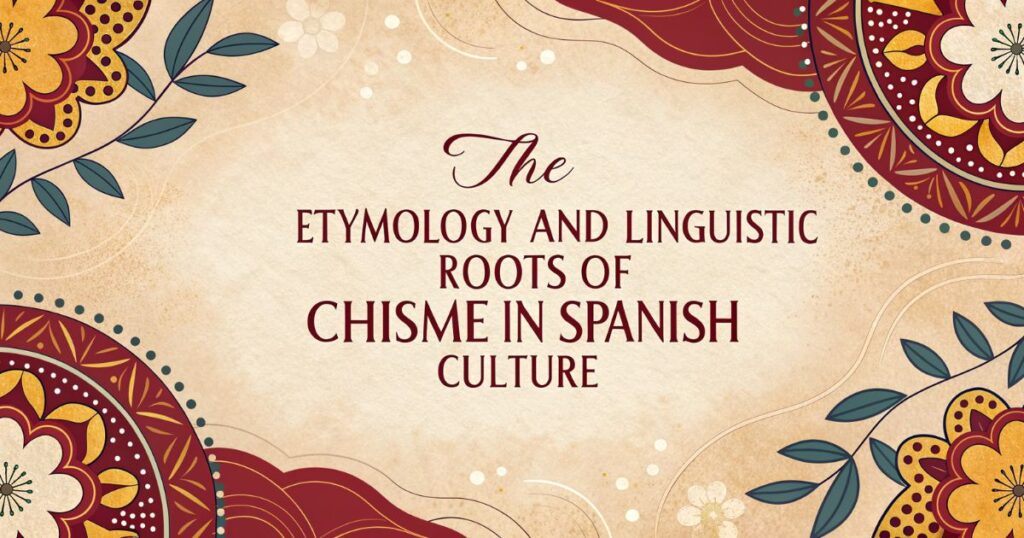Ever wondered why your Latina neighbor seems to know everything happening on the block? The answer lies in chisme – a cultural phenomenon that goes far deeper than simple gossip.
While Americans might dismiss it as idle chatter, chisme serves as the social glue binding Latino communities together across generations.
What Does Chisme Actually Mean Beyond Simple Gossip
Chisme translates literally to “gossip” in English, but this translation barely scratches the surface. Think of it as community intelligence gathering with emotional investment attached.
Unlike casual American gossip, chisme carries cultural weight. It’s how families stay connected across distances, how neighborhoods maintain safety networks, and how traditions get passed down through storytelling.
The word itself comes from the verb “chismear,” meaning to share news or rumors. However, within Latino culture, this sharing often serves protective and connective purposes that pure gossip lacks.
Consider this: when your tía calls to share chisme about a cousin’s job loss, she’s not just spreading rumors. She’s activating a support network, preparing family members to offer help, and maintaining the emotional fabric of extended family relationships.
The Etymology and Linguistic Roots of Chisme in Spanish Culture

The word chisme traces back to medieval Spanish, possibly derived from the Arabic “shisma,” meaning division or split. This etymology reveals something profound about its original purpose – highlighting social fractures that communities needed to address.
Historical records show chisme functioning as an early warning system in Spanish villages. Women would gather at wells, markets, and doorsteps, sharing information about traveling merchants, potential threats, or community changes.
Spanish conquistadors brought this communication style to the Americas, where it merged with indigenous information-sharing traditions. The result? A hybrid cultural practice that served survival needs in unfamiliar territories.
Modern Spanish dictionaries define chisme neutrally, but cultural context adds layers of meaning. Regional variations emerged as the practice adapted to different Latino cultures across continents.
How Chisme Differs from Regular Gossip in American Culture
American gossip often focuses on celebrity scandals or workplace drama – entertainment with emotional distance. Chisme, however, centers on people within your immediate community circle.
Purpose drives the difference. American gossip tends toward idle entertainment or social positioning. Chisme frequently serves practical functions: warning about dangerous situations, sharing job opportunities, or coordinating family support.
Emotional investment separates them too. When someone shares chisme, they’re personally invested in the outcome. American gossip allows spectator distance – you can discuss celebrity breakups without feeling responsible for reconciliation.
Chisme also carries accountability expectations. If you share information about family struggles, you’re expected to offer help or solutions. American gossip rarely creates such obligations.
The frequency differs dramatically. Studies show Latino families engage in information-sharing conversations 40% more often than average American households, with chisme serving as daily social maintenance.
Regional Variations of Chisme Across Latin American Countries
Mexican chisme often revolves around extended family networks and neighborhood dynamics. The practice thrives in close-knit communities where everyone knows multiple generations of each family.
In Puerto Rico, chisme takes on political dimensions, with community news often intertwining with local politics and social issues. Island culture intensifies the practice since geographic boundaries concentrate social networks.
Colombian chisme frequently includes economic information – job opportunities, business changes, or financial struggles. This practical focus reflects cultural emphasis on community economic support.
Argentinian chisme tends toward dramatic storytelling, with elaborate details and emotional flourishes. The European influence shows in the theatrical presentation style.
Cuban chisme often carries historical weight, connecting current events to family migration stories or political experiences. Each piece of news links to broader cultural narratives.
Dominican chisme emphasizes relationship dynamics, particularly romantic entanglements and family disputes. The practice serves as informal relationship counseling and conflict resolution.
The Social Psychology Behind Why People Share Chisme
Humans are wired for social information gathering. Chisme satisfies this evolutionary need while strengthening community bonds through shared knowledge.
Belonging drives participation. When someone includes you in chisme, they’re signaling your membership in their inner circle. Exclusion from information sharing often indicates social rejection.
Research shows that 65% of human conversation involves sharing information about social relationships and community events. Chisme formalizes this natural tendency within cultural frameworks.
Status plays a role too. Being the first to share important chisme elevates social standing. Knowledge becomes currency in community economies of influence and respect.
Fear motivates some chisme sharing. In communities facing economic uncertainty or social challenges, information sharing provides security through collective awareness and mutual support systems.
Empathy fuels the practice. People share chisme because they care about community members’ wellbeing and want others to care too.
Chisme as Community Bonding vs Harmful Rumor Spreading
Positive chisme strengthens community connections by sharing celebratory news, coordinating support for struggling families, or maintaining cultural traditions through storytelling.
Harmful chisme damages relationships through malicious rumors, privacy violations, or deliberate misinformation designed to hurt specific individuals or families.
The difference often lies in intention and outcome. Constructive chisme aims to help, protect, or celebrate community members. Destructive versions seek to harm, embarrass, or exclude.
Context matters significantly. Sharing news about someone’s job loss becomes positive chisme when aimed at organizing support. The same information becomes harmful when used to shame or gossip maliciously.
Latino families often teach children to distinguish between helpful information sharing and hurtful rumor spreading. This education helps maintain chisme’s positive community functions while minimizing damage.
Accountability checks exist in healthy communities. Elders or respected members intervene when chisme becomes destructive, redirecting conversations toward constructive outcomes.
Gender Roles and Chisme in Traditional Latino Households
Women traditionally serve as chisme networks’ primary architects and maintainers. This role reflects historical gender divisions where men worked outside homes while women managed community relationships.
Abuelitas (grandmothers) often function as information hubs, collecting and distributing chisme that keeps extended families connected. Their wisdom helps filter helpful information from harmful rumors.
Men participate in chisme differently, often focusing on work-related information, sports updates, or political developments. Their version typically carries less emotional investment and relationship analysis.
Generational transmission occurs primarily through mother-daughter relationships. Young women learn appropriate chisme sharing by observing maternal communication patterns and community responses.
Modern gender roles are shifting these patterns. Second-generation Latinas often balance traditional chisme practices with American privacy expectations, creating hybrid communication styles.
Machismo influences how men engage with chisme. Some view it as feminine activity, while others recognize its community importance and participate selectively.
Modern Digital Chisme Through Social Media and WhatsApp Groups
WhatsApp family groups have revolutionized chisme sharing, allowing instant communication across geographic distances. Extended families maintain daily contact through shared photos, voice messages, and breaking news updates.
Facebook transforms traditional chisme by making private information semi-public. Family events, relationship changes, and personal struggles become community knowledge through social media sharing.
Instagram Stories create new chisme categories, with family members sharing daily activities that generate conversation and community connection across platforms.
Digital chisme moves faster but sometimes lacks the filtering wisdom of traditional face-to-face sharing. Misinformation spreads more quickly without elder intervention or community verification.
Privacy concerns arise as digital chisme reaches broader audiences than intended. Traditional boundaries between family information and public knowledge become blurred online.
Generational conflicts emerge when older family members share too much personal information online, while younger generations prefer more privacy boundaries.
The Art of Chismear – When Sharing News Becomes Cultural Currency
Chismear (the act of sharing chisme) requires skill, timing, and cultural sensitivity. Master practitioners know exactly how much information to share, when to share it, and with whom.
Timing matters critically. Sharing chisme too early might spread unverified information. Sharing too late reduces your social value as an information source.
Audience selection determines chisme’s impact. Skilled practitioners know which family members need specific information and who might misuse or misinterpret details.
Delivery style affects reception. Experienced chisme sharers use appropriate tone, emotional context, and supporting details to ensure their message achieves intended outcomes.
Reciprocity expectations govern exchanges. People who receive chisme regularly are expected to contribute their own information to maintain social balance.
Cultural capital accumulates through consistent, reliable chisme sharing. Community members gain respect and influence by proving themselves trustworthy information sources.
Positive Functions of Chisme in Maintaining Community Connections
Safety networks emerge from chisme sharing. When families know about neighborhood problems, domestic issues, or health concerns, they can offer timely help and protection.
Economic support gets coordinated through chisme channels. Information about job openings, business opportunities, or financial struggles helps communities allocate resources effectively.
Cultural preservation happens through storytelling chisme. Family histories, traditional recipes, and cultural practices get transmitted alongside current news and updates.
Emotional support flows through chisme networks. Families facing challenges receive encouragement, advice, and practical help when their situations become community knowledge.
Social accountability maintains through chisme awareness. Community members behave more responsibly when they know their actions will become family or neighborhood news.
Celebration amplification occurs when positive chisme spreads good news quickly, allowing communities to share joy and pride in members’ achievements.
Recognizing Toxic Chisme and Setting Healthy Boundaries
Warning signs of toxic chisme include deliberate privacy violations, malicious intent, factual distortions, and persistent focus on negative information about specific individuals.
Emotional damage results from toxic chisme through reputation destruction, family conflict escalation, and community relationship breakdown.
Boundary setting requires clear communication about information preferences. You can request that certain personal details remain private while staying connected to community networks.
Selective participation allows you to engage with positive chisme while avoiding harmful varieties. Choose carefully which conversations to join and which information to share.
Family discussions about chisme boundaries help establish household rules about privacy expectations and appropriate information sharing.
Professional help might be necessary when toxic chisme creates serious family conflicts, mental health impacts, or community relationship damage.
Chisme in Popular Media – Telenovelas, Music, and Literature
Telenovelas rely heavily on chisme dynamics to drive plot development. Characters constantly share secrets, spread rumors, and use information strategically to advance storylines.
Regional Mexican music frequently references chisme culture, with songs about neighborhood gossip, family drama, and community relationships reflecting real-life experiences.
Latino literature explores chisme’s complex role in family dynamics, community identity, and cultural preservation across generations and geographic boundaries.
Reality TV shows targeting Latino audiences often feature chisme-heavy content, recognizing its cultural appeal and entertainment value.
Social media influencers adapt traditional chisme sharing for digital audiences, creating content that mimics family information networks but reaches thousands of followers.
Comedy shows frequently use chisme scenarios for humor, highlighting both positive and negative aspects of information-sharing culture.
How Second-Generation Latinos Navigate Chisme Culture in America
Cultural conflicts arise when traditional chisme practices clash with American privacy expectations and individualistic values.
Language barriers affect chisme participation when second-generation Latinos struggle with Spanish fluency needed for full community integration.
Generational tensions develop when younger family members resist traditional information-sharing expectations while elders feel excluded from their lives.
Adaptation strategies include selective participation, cultural translation for non-Latino friends, and boundary negotiation within families.
Identity formation gets influenced by chisme participation levels, with some second-generation Latinos using engagement to maintain cultural connections.
Professional challenges emerge when workplace cultures conflict with family chisme expectations, requiring careful balance between cultural loyalty and career advancement.
The Difference Between Chisme, Cotilleo, and Other Spanish Gossip Terms
Chisme carries cultural weight and community function, while cotilleo (used in Spain) tends toward lighter, more superficial gossip without deep social implications.
Murmuración suggests malicious intent and deliberately harmful information sharing, carrying more negative connotations than neutral chisme.
Habladurías refers to unverified rumors or hearsay, emphasizing the uncertain nature of information rather than its social function.
Comidilla describes something that becomes common conversation topic, focusing on the subject rather than the sharing process.
Regional preferences vary significantly. Mexican families typically use chisme, while some South American countries prefer alternative terms with similar but distinct cultural meanings.
Context determines which term applies. The same information sharing might be chisme in supportive contexts but murmuración when intended to harm.
Professional Settings and Workplace Chisme Among Latino Communities
Workplace dynamics shift when Latino employees bring chisme culture to professional environments. Information sharing helps build relationships but may conflict with corporate privacy expectations.
Networking benefits emerge from workplace chisme when information about opportunities, company changes, or professional development gets shared within Latino employee groups.
Cultural mentorship occurs through workplace chisme as experienced Latino employees guide newcomers using traditional information-sharing methods.
Professional boundaries require careful navigation between cultural authenticity and workplace appropriateness, especially in diverse professional environments.
Leadership challenges arise when Latino managers must balance cultural communication styles with corporate policies about information sharing and confidentiality.
Success strategies include adapting chisme principles to professional contexts while respecting workplace cultures and legal requirements.
Teaching Children About Responsible Information Sharing vs Chisme
Age-appropriate discussions help children understand the difference between helpful information sharing and harmful gossip, building critical thinking skills about communication choices.
Cultural pride gets balanced with privacy awareness as children learn to value their heritage while respecting others’ boundaries.
Role modeling by parents demonstrates positive chisme practices while avoiding harmful varieties, giving children concrete examples of appropriate behavior.
Consequence education helps children understand how information sharing affects relationships, reputations, and community dynamics.
Digital literacy becomes crucial as children learn to navigate online chisme through social media platforms and family group chats.
Cultural continuity gets maintained when children appreciate chisme’s positive functions while developing skills to avoid its harmful aspects.
Conclusion
Chisme represents far more than simple gossip – it’s a cultural practice that builds community, preserves traditions, and maintains family connections across generations.
Understanding its nuanced meaning helps bridge cultural gaps while appreciating Latino community dynamics. Whether you’re learning Spanish, building relationships with Latino colleagues, or simply curious about different cultures, recognizing chisme’s true significance opens doors to deeper cultural appreciation and more meaningful cross-cultural connections.
More Posts
Voyeurism Term in English: Simple Explanation & Examples
WTW Meaning: Complete Guide to the Acronym and Its Uses
Black Heart Meaning: Understanding Its Symbolism and Purpose

Welcome to Brightnis! I am the admin and creator of this platform. I love questioning ideas and exploring different situations. My goal is to encourage critical thinking and help people see things from new perspectives. Join me in discussing thought-provoking topics and finding unique solutions to everyday challenges!




![225+ Spicy Questions To Ask Your Crush [The Ultimate Collection] 225+ Spicy Questions To Ask Your Crush](https://brightnis.com/wp-content/uploads/2025/05/225-Spicy-Questions-To-Ask-Your-Crush-The-Ultimate-Collection-150x150.jpg)

